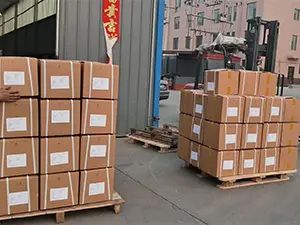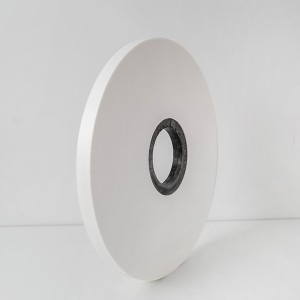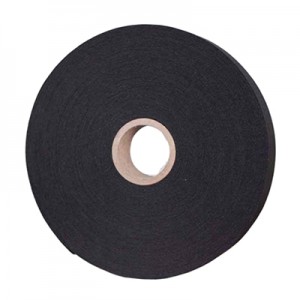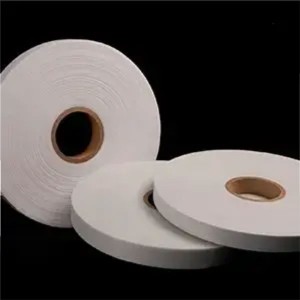
محصولات
د غیر اوبدل شوي ټوکر ټیپ
د محصول پیژندنه
غیر اوبدل شوي ټوکر ټیپ د ټیپ مواد دي چې د لوړ تودوخې مقاومت لرونکي پالیسټر فایبرونو څخه جوړ شوي چې د ډوبولو، تړلو، وچولو، او فشارولو له لارې، او بیا ټوټه ټوټه کیږي.
د غیر اوبدل شوي ټوکر ټیپ په پراخه کچه د تار او کیبل صنعت کې کارول کیږي. دا د بریښنا کیبل، ربړ پوښل شوي کیبل، کنټرول کیبل، د مخابراتو کیبل او د مخابراتو نظری کیبل، او نورو لپاره د جلا کولو پرت، کشن پرت او د تودوخې محافظت پرت په توګه کارول کیدی شي. د کیبل او نظری کیبل تولید پروسې په جریان کې، دا کولی شي د کیبل کور په سمولو کې مرسته وکړي، او کولی شي د ایستل شوي پرتونو ترمنځ جلا کول ډاډمن کړي. د غیر اوبدل شوي ټوکر ټیپ کارول کولی شي د کیبل او نظری کیبل میخانیکي ځواک او انعطاف هم زیات کړي.
ځانګړتیاوې
هغه غیر اوبدل شوی ټیپ چې موږ یې چمتو کړی لاندې ځانګړتیاوې لري:
۱) ښه یوشانوالی، هیڅ ډول ډیلیمینیشن نشته.
۲) لږ وزن، نری ضخامت او ښه انعطاف.
۳) لوړ میخانیکي ځواک، د پوښلو او اوږدوالي پوښلو لپاره اسانه.
۴) د تودوخې ښه مقاومت، د تودوخې لوړ فوري مقاومت، او کیبل کولی شي د فوري لوړې تودوخې لاندې باثباته فعالیت وساتي.
۵) لوړ کیمیاوي ثبات، هیڅ زنګ وهونکي اجزا نلري، د باکتریا او فنګس تخریب په وړاندې مقاومت لري.
غوښتنلیک
په عمده توګه د جلا کولو طبقې، کشن طبقې او د بریښنا کیبل د تودوخې محافظت طبقې، ربړ پوښل شوي کیبل، کنټرول کیبل، د مخابراتو کیبل، او د مخابراتو نظری کیبل، او داسې نورو په توګه کارول کیږي.
تخنیکي پیرامیټرې
| توکي | تخنیکي پیرامیټرې | ||
| نومول شوی ضخامت (ملي میتر) | ۰.۰۵ | ۰.۱ | ۰.۱۲ |
| د کشش قوت (N/cm) | ≥۳۰ | ≥۳۵ | ≥۴۰ |
| د ماتولو اوږدوالی (٪) | ≥۱۲ | ≥۱۲ | ≥۱۰ |
| د اوبو تناسب (٪) | ≤۵ | ≤۵ | ≤۵ |
| اوږدمهاله ثبات (℃) | 90 | 90 | 90 |
| لنډمهاله ثبات (℃) | ۲۳۰ | ۲۳۰ | ۲۳۰ |
| یادونه: نور مشخصات، مهرباني وکړئ زموږ د پلور کارمندانو سره اړیکه ونیسئ. | |||
بسته بندي
د غیر اوبدل شوي ټوکر ټیپ د رطوبت ضد فلم کڅوړې سره پوښل کیږي، په کارتن کې اچول کیږي او د تختې په واسطه بسته کیږي، او په پای کې د لپاس کولو فلم سره پوښل کیږي.
د کارتن اندازه: ۵۵ سانتي متره * ۵۵ سانتي متره * ۴۰ سانتي متره
د بسته بندۍ اندازه: ۱.۱ متره*۱.۱ متره*۲.۱ متره

ذخیره کول
۱) محصول باید په پاک، وچ او هوا لرونکي ګودام کې وساتل شي.
۲) محصول باید د اور اخیستونکو محصولاتو سره یوځای ونه ساتل شي او باید د اور سرچینو ته نږدې نه وي.
۳) محصول باید د مستقیم لمر او باران څخه ډډه وکړي.
۴) محصول باید په بشپړه توګه بسته شي ترڅو د لندبل او ککړتیا څخه مخنیوی وشي.
۵) محصول باید د ذخیره کولو پرمهال د دروند فشار او نورو میخانیکي زیانونو څخه خوندي شي.
د نمونې وړیا شرایط
ون ورلډ ژمن دی چې پیرودونکو ته د صنعتي لوړ کیفیت تار او کیبل موادو او لومړي درجې تخنیکي خدماتو چمتو کولو لپاره ژمن دی.
تاسو کولی شئ د هغه محصول وړیا نمونې غوښتنه وکړئ چې تاسو یې لیوالتیا لرئ پدې معنی چې تاسو زموږ محصول د تولید لپاره کارولو ته لیواله یاست.
موږ یوازې هغه تجربوي معلومات کاروو چې تاسو یې د محصول ځانګړتیاو او کیفیت د تایید په توګه د نظر ورکولو او شریکولو لپاره لیواله یاست، او بیا موږ سره د کیفیت کنټرول بشپړ سیسټم رامینځته کولو کې مرسته کوو ترڅو د پیرودونکو باور او پیرود اراده ښه کړو، نو مهرباني وکړئ ډاډ ترلاسه کړئ.
تاسو کولی شئ د وړیا نمونې غوښتنه کولو لپاره فورمه په ښي خوا ډکه کړئ.
د غوښتنلیک لارښوونې
۱. هغه پیرودونکی چې د نړیوال ایکسپریس تحویلي حساب لري په خپله خوښه د بار وړلو پیسې ورکوي (بار په ترتیب سره بیرته راستنیدلی شي)
۲. ورته اداره کولی شي د ورته محصول یوازې یو وړیا نمونې لپاره غوښتنه وکړي، او ورته اداره کولی شي د یو کال په اوږدو کې د مختلفو محصولاتو تر پنځو نمونو پورې وړیا غوښتنه وکړي.
۳. نمونه یوازې د تار او کیبل فابریکې پیرودونکو لپاره ده، او یوازې د لابراتوار پرسونل لپاره د تولید ازموینې یا څیړنې لپاره ده.
د نمونې بسته بندي
د وړیا نمونې غوښتنې فورمه
مهرباني وکړئ د نمونې اړین مشخصات دننه کړئ، یا د پروژې اړتیاوې په لنډه توګه تشریح کړئ، موږ به ستاسو لپاره نمونې وړاندیز کړو.
د فورمې له سپارلو وروسته، هغه معلومات چې تاسو یې ډکوئ ممکن د ONE WORLD پس منظر ته د محصول مشخصاتو او پتې معلوماتو د ټاکلو لپاره د نورو پروسس کولو لپاره لیږدول شي. او ممکن تاسو سره د تلیفون له لارې هم اړیکه ونیسي. مهرباني وکړئ زموږ ولولئد محرمیت تګلارهد نورو جزیاتو لپاره.











